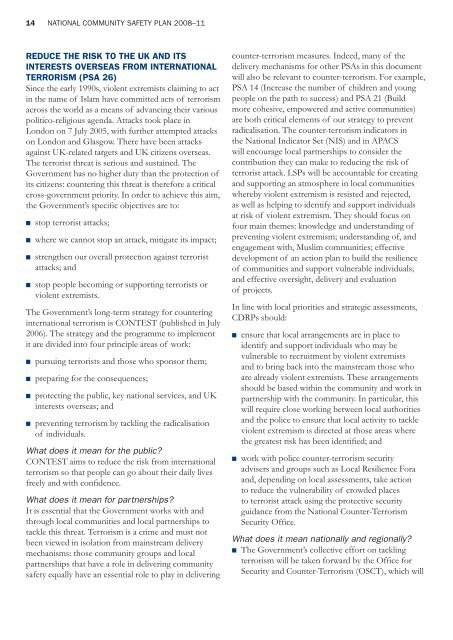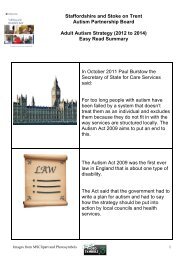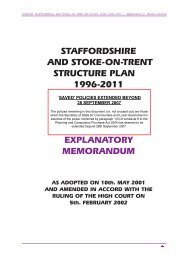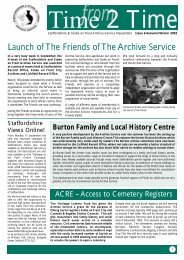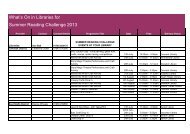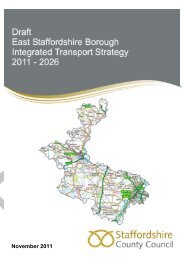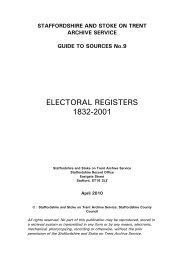nationalCommunitySafetyPlan200811 - Staffordshire County Council
nationalCommunitySafetyPlan200811 - Staffordshire County Council
nationalCommunitySafetyPlan200811 - Staffordshire County Council
You also want an ePaper? Increase the reach of your titles
YUMPU automatically turns print PDFs into web optimized ePapers that Google loves.
14 NATIONAL COMMUNITY SAFETY PLAN 2008–11<br />
REDUCE THE RISK TO THE UK AND ITS<br />
INTERESTS OVERSEAS FROM INTERNATIONAL<br />
TERRORISM (PSA 26)<br />
Since the early 1990s, violent extremists claiming to act<br />
in the name of Islam have committed acts of terrorism<br />
across the world as a means of advancing their various<br />
politico-religious agenda. Attacks took place in<br />
London on 7 July 2005, with further attempted attacks<br />
on London and Glasgow. There have been attacks<br />
against UK-related targets and UK citizens overseas.<br />
The terrorist threat is serious and sustained. The<br />
Government has no higher duty than the protection of<br />
its citizens: countering this threat is therefore a critical<br />
cross-government priority. In order to achieve this aim,<br />
the Government’s specifi c objectives are to:<br />
■ stop terrorist attacks;<br />
■ where we cannot stop an attack, mitigate its impact;<br />
■ strengthen our overall protection against terrorist<br />
attacks; and<br />
■ stop people becoming or supporting terrorists or<br />
violent extremists.<br />
The Government’s long-term strategy for countering<br />
international terrorism is CONTEST (published in July<br />
2006). The strategy and the programme to implement<br />
it are divided into four principle areas of work:<br />
■ pursuing terrorists and those who sponsor them;<br />
■ preparing for the consequences;<br />
■ protecting the public, key national services, and UK<br />
interests overseas; and<br />
■ preventing terrorism by tackling the radicalisation<br />
of individuals.<br />
What does it mean for the public?<br />
CONTEST aims to reduce the risk from international<br />
terrorism so that people can go about their daily lives<br />
freely and with confi dence.<br />
What does it mean for partnerships?<br />
It is essential that the Government works with and<br />
through local communities and local partnerships to<br />
tackle this threat. Terrorism is a crime and must not<br />
been viewed in isolation from mainstream delivery<br />
mechanisms: those community groups and local<br />
partnerships that have a role in delivering community<br />
safety equally have an essential role to play in delivering<br />
counter-terrorism measures. Indeed, many of the<br />
delivery mechanisms for other PSAs in this document<br />
will also be relevant to counter-terrorism. For example,<br />
PSA 14 (Increase the number of children and young<br />
people on the path to success) and PSA 21 (Build<br />
more cohesive, empowered and active communities)<br />
are both critical elements of our strategy to prevent<br />
radicalisation. The counter-terrorism indicators in<br />
the National Indicator Set (NIS) and in APACS<br />
will encourage local partnerships to consider the<br />
contribution they can make to reducing the risk of<br />
terrorist attack. LSPs will be accountable for creating<br />
and supporting an atmosphere in local communities<br />
whereby violent extremism is resisted and rejected,<br />
as well as helping to identify and support individuals<br />
at risk of violent extremism. They should focus on<br />
four main themes: knowledge and understanding of<br />
preventing violent extremism; understanding of, and<br />
engagement with, Muslim communities; effective<br />
development of an action plan to build the resilience<br />
of communities and support vulnerable individuals;<br />
and effective oversight, delivery and evaluation<br />
of projects.<br />
In line with local priorities and strategic assessments,<br />
CDRPs should:<br />
■ ensure that local arrangements are in place to<br />
identify and support individuals who may be<br />
vulnerable to recruitment by violent extremists<br />
and to bring back into the mainstream those who<br />
are already violent extremists. These arrangements<br />
should be based within the community and work in<br />
partnership with the community. In particular, this<br />
will require close working between local authorities<br />
and the police to ensure that local activity to tackle<br />
violent extremism is directed at those areas where<br />
the greatest risk has been identifi ed; and<br />
■ work with police counter-terrorism security<br />
advisers and groups such as Local Resilience Fora<br />
and, depending on local assessments, take action<br />
to reduce the vulnerability of crowded places<br />
to terrorist attack using the protective security<br />
guidance from the National Counter-Terrorism<br />
Security Offi ce.<br />
What does it mean nationally and regionally?<br />
■ The Government’s collective effort on tackling<br />
terrorism will be taken forward by the Offi ce for<br />
Security and Counter-Terrorism (OSCT), which will


